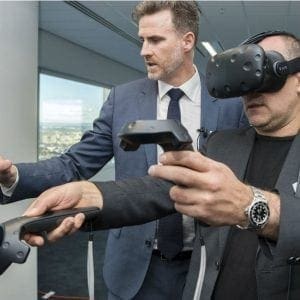
As a patriotic Canadian, it always brings me great joy to see a fellow countryman achieve worldwide success and be at the forefront of his or her given field. Hence, it was an absolute delight to reconnect with Alessandro Munge, Founder and President of Studio Munge (www.studiomunge.com), for an interview at his office just a short drive from my house here in Toronto.
In this current era of disruption, hotel design is proving itself to be an inescapable tool for survival. No longer is it only accessible to five-star properties or a vanity project for billionaire owners. Rather, design is now a key differentiator for all hotels in the face of near-infinite travel accommodation options. The spaces we invite our guests to experience must constantly elicit a positive emotional response. To cite the two most commonly discussed aspects, a lobby must strike an impression and a guestroom is no longer just a room.
I first worked with Alessandro when we were both helping build The William Vale in Brooklyn, New York. Needless to say, I was blown away by his team’s ability to create unique points of differentiation, both large and grand as well as small and subtle, throughout every space in the property. For me, it was a true eyeopener as to the possibilities for what design can do to boost the profile of a hotel and generate a seemingly endless succession of praise from incoming guests as well as locals. To shed some more light on how any hotel, no matter the star rating or capex budget, can implement changes to increase guest appeal, Alessandro dives into his design process and some of the trends for the next half decade.
What’s your take on the importance hotel design, and where are we heading in the next few years?
Firstly, brands and operators are now realizing the impact and importance of design when it comes to creating a distinct identity for their hotels. Now that buying powers are transitioning to a new generation, we see a clear change in this, and guests are researching more than ever for uniqueness and experiential. They are always on the look for fresh and new.

Because of that, we are witnessing a decline in brand fidelity, but fear not as brands are actively adapting to the evolving market. With our help, they are transitioning into exceptional concept-driven properties. Although this is a great time for us to shine, it puts tremendous pressure on our industry to push the boundaries and deliver a design solution that is truly unique beyond Ôresidential feel’ or bathrooms that are Ôspa-like’; this just won’t cut it anymore. We should be focused on the guest and his or her expectations. We must also think about innovative programming and space planning, technology integration, and engagement with the local environment.
On the developers’ side, brand and non-brands must clearly identify their markets and their tribes, then commit to this audience so the message can be clearly designed, crafted and delivered. It is an illusion to think that all hotels will cater to every individual; the experience must be precisely tailored. The William Vale in Brooklyn is a great example of all the above successfully integrated into an innovative design-centric property. With already over a dozen international awards won for the project, it is no accident the hotel is running incredibly high occupancy rates and bringing in record numbers.
How does design play a role in guestroom space maximization?
It is my prerogative to fully understand the developer’s vision and the guest’s expectation in the case of a branded property before coming up with the most appropriate programming and space planning to host all required room functions. Once the framework is set, I take great pride in creating a uniquely integrated experience for the end user together with our team of talented designers and consultants. This controlled process guarantees a most effective use of space while maximizing allocated budgets, tight specification packages that can easily be tendered to multiple vendors, a rigorous prototyping process, and a seamless delivery Ð all key components to a successful award-winning project.
Do you have your own design personality or is every project a unique challenge?
 More than ever designers around the world are embracing eclecticism in their portfolios, which completely relates to the time we live in. The modern guest is design savvy; there is just no room for repetition in today’s day and age. Our challenge becomes the speed and quality at which you can reinvent yourself as well as your capability to pick the most relevant solution for the client when presented a myriad of options while creating something unpredictable.
More than ever designers around the world are embracing eclecticism in their portfolios, which completely relates to the time we live in. The modern guest is design savvy; there is just no room for repetition in today’s day and age. Our challenge becomes the speed and quality at which you can reinvent yourself as well as your capability to pick the most relevant solution for the client when presented a myriad of options while creating something unpredictable.
Some crumble, but I personally thrive in that environment! When clients come to us, they understand we have the highest of standards and that we’ll deliver something on point even though they have absolutely no clue what it’s going to look like initially. I start with a blank canvas and love building up that tension before our first narrative presentation. Seeing the excitement in our client’s eyes as they discover my vision is priceless. Some laugh, some clap and some even cry with joy as I unravel the mystery and tap into emotional memories.
How do you reconcile the two disciplines of fine art and interior design?
Anyone who has visited our studio and witnessed the dozens of pieces on our walls knows how passionate I am about art; it brings me so much joy to build our collection and surround myself with those beautiful expressions of creativity. Art is undeniably one of the most important components of a project; it can really make or break a room. To control and integrate the art program as much as possible, we have our expert in-house art consultant dedicated to creating a truly holistic experience that in sync with our narrative and design intent. We always go through an in-depth selection process to guarantee authenticity and uniqueness. At The William Vale, we reached out to the Pratt Institute to discover up-and-coming local artists for each floor, and then organized a competition between a few Brooklyn-based artists for the lobby lounge’s installation. Another example is our latest hotel to open in Toronto Ð the Bisha Hotel, a Loews property Ð which hosts a serious collection of close to 3,000 pieces by incredible artists including Jeff Koons, Damien Hirst, Andy Warhol, John Baldessari and many more.
With a limited budget, would you advise that it be spent on public spaces or guestrooms?
I wish it was that easy! My advice would be to have a blank slate when working with a designer who can then fully control procurement. This allows us to most appropriately distribute the budget in both public spaces and guestrooms for maximum impact while preserving the design intent. The absolute worst option a developer could pick is to value engineer without design control; it will end up looking cheap and discombobulated. Ensuring money is spent well and in the most impactful spaces is a key strength of ours. It isn’t about focusing all budget in one area, but rather it is about spreading it out so the journey is felt continuously by the hotel guest. Having said that, I do like to weigh a little more funds in public spaces as the first impression always counts and because these places require fundamental architectural statements that we sometimes cannot do without, whereas my approach to guestroom interiors is more geared towards a curated experience of furniture.
How has Canada influenced your proposed designs?
In terms of design influence, my Italian heritage as well as my love for fashion, architecture, travel and art have all had a much greater impact on my work. Fashion references, authenticity in materiality, detailing and legendary craftsmanship are all infused in our projects. But Toronto as a prime example for multiculturalism has certainly taught me to appreciate cultural diversity, allowing me to better understand the human mind.
I have always known that working in one city simply wouldn’t cut it for me. I love meeting different people and experiencing different cultures. It’s exciting to bring in these inspirations and influences in our projects for our clients. Travel and locale ultimately is my biggest source of inspiration to infuse our projects with a sense of place. Our current work on the Park Hyatt here in Toronto, for instance, will have a very Canadian slant to it and will respect our country and heritage in a very contemporary way Ð all re-imagined by Studio Munge so it won’t be contrived or predictable.
About the author
 One of the world’s most published writer in hospitality, Larry Mogelonsky is the principal ofÊHotel Mogel Consulting Limited, a Toronto-based consulting practice. His experience encompasses hotel properties around the world, both branded and independent, and ranging from luxury and boutique to select-service. Larry is also on several boards for companies focused on hotel technology. His work includes four books ÒAre You an Ostrich or a Llama?Ó (2012), ÒLlamas RuleÓ (2013), ÒHotel LlamaÓ (2015), and ÒThe Llama is InnÓ (2017). You can reach Larry atÊlarry@hotelmogel.comÊto discuss hotel business challenges or to book speaking engagements.
One of the world’s most published writer in hospitality, Larry Mogelonsky is the principal ofÊHotel Mogel Consulting Limited, a Toronto-based consulting practice. His experience encompasses hotel properties around the world, both branded and independent, and ranging from luxury and boutique to select-service. Larry is also on several boards for companies focused on hotel technology. His work includes four books ÒAre You an Ostrich or a Llama?Ó (2012), ÒLlamas RuleÓ (2013), ÒHotel LlamaÓ (2015), and ÒThe Llama is InnÓ (2017). You can reach Larry atÊlarry@hotelmogel.comÊto discuss hotel business challenges or to book speaking engagements.
This article may not be reproduced without the expressed permission of the author.















